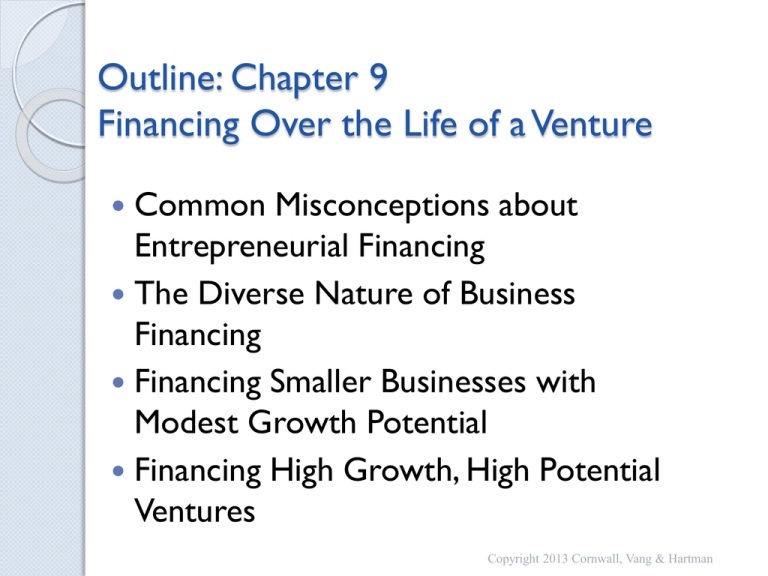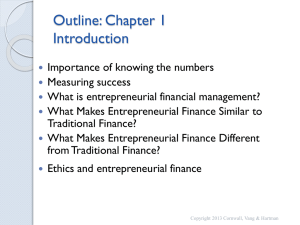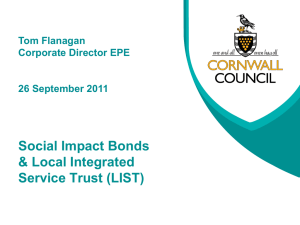
Outline: Chapter 9
Financing Over the Life of a Venture
Common Misconceptions about
Entrepreneurial Financing
The Diverse Nature of Business
Financing
Financing Smaller Businesses with
Modest Growth Potential
Financing High Growth, High Potential
Ventures
Copyright 2013 Cornwall, Vang & Hartman
Common Misconceptions about
Entrepreneurial Financing
Venture Capitalists Fund Most Businesses
Banks Lend to Start-ups
SBA lends money directly to
entrepreneurs
Entrepreneurs Tend to Rely on One Single
Source of Funding
Government Grants are a Good Source
of Money for Small Businesses
Copyright 2013 Cornwall, Vang & Hartman
The Diverse Nature of Business
Financing
The Nature of the Business Model
Aspirations of the Entrepreneur
The Stage of Development of the
Business Venture
Fitting the Pieces of the Financing Puzzle
Together
Copyright 2013 Cornwall, Vang & Hartman
Financing a Small Business - Modest Growth
Figure 9.1
Pre-launch
Start-up
Growth
Transition
Bootstrapping
Self, friends, and family
Equity financing
Debt financing
Copyright 2013 Cornwall, Vang & Hartman
Financing a High-Growth, High-Potential Venture
Figure 9.2
Pre-launch
Start-up
Growth
Transition
Bootstrapping
Seed financing from angels
Equity financing from VCs
Debt financing
Copyright 2013 Cornwall, Vang & Hartman
Outline: Chapter 10
Start-up Financing From the Entrepreneur, Friends
and Family
Self-financing
Advantages and Disadvantages of Selffinancing
Friends and Family Financing
Structure of Funds Invested
◦ Loan
◦ Equity
Copyright 2013 Cornwall, Vang & Hartman
Most Common Sources of Financing
Figure 10.1
Pre-launch
Start-up
Growth
Transition
Self, friends, and family
Copyright 2013 Cornwall, Vang & Hartman
Advantages and Disadvantages of Self-Financing
Table 10.1
Advantages
Disadvantages
Relative ease of securing funding
May limit size and scope of start-up
Avoid complexity created by adding
partners
Better alignment with
entrepreneur’s aspirations
No dilution of profits or gains
May limit ability to grow
Increases exposure to personal risk
from business failure
Entrepreneur may lack all necessary
experience, contacts, skills, and/or
knowledge
Eventual exit process is often
simpler
Copyright 2013 Cornwall, Vang & Hartman
Friends and Family Financing
Determine True Motivations
Use a Formal Business Plan
Provide Accurate, Objective, and Full
Information about the Business
Keep Boundaries
Tax Planning
Copyright 2013 Cornwall, Vang & Hartman
Outline: Chapter 11
Bootstrapping
Why bootstrap?
Bootstrapping Administrative Overhead
Bootstrapping Employee Expenses
Bootstrapping Operating Expenses
Bootstrap Marketing
The Ethics of Bootstrapping
Copyright 2013 Cornwall, Vang & Hartman
Bootstrapping Throughout the Life of a Venture
Figure 11.1
Pre-launch
Start-up
Growth
Transition
Bootstrapping
Copyright 2013 Cornwall, Vang & Hartman
Bootstrapping
Defined as the “process of finding creative
ways exploit opportunities to launch
and grow businesses with the limited
resources available for most start-up
ventures.”
Cornwall, J. (2010). Bootstrapping. Englewood Cliffs, NJ: Pearson/Prentice-Hall.
Copyright 2013 Cornwall, Vang & Hartman
Why Bootstrap?
Often necessary for small businesses to
get started
Difficulty in raising money for growth
Preserves the value and wealth of a
business
“Extend the Runway”
Reduce risk associated with debt
financing
Copyright 2013 Cornwall, Vang & Hartman
Rules of Bootstrapping
Rule #1: Overhead matters
Rule #2: Employee expenses are usually
the highest single recurring cost
Rule #3: Minimize operating costs
Rule #4: Marketing matters, but know
your customers and how they make
decisions
Copyright 2013 Cornwall, Vang & Hartman
Bootstrapping Administrative Overhead
Space
Furnishings and office equipment
Administrative salaries
Copyright 2013 Cornwall, Vang & Hartman
Bootstrapping Employee Expenses
Independent contractors
Employee leasing and temporary
employees
Student interns
Equity compensation
Non-monetary benefits
Copyright 2013 Cornwall, Vang & Hartman
Bootstrapping Operating Expenses
Outsourcing
Just-in-time inventory techniques
Effective cost accounting
Copyright 2013 Cornwall, Vang & Hartman
Bootstrap Marketing
Know your customer
Focus on the impact of message, not
“volume”
Focus on benefits for customer
Understand the market niche
Spend your marketing dollars wisely
Marketing is a process, not an event
Copyright 2013 Cornwall, Vang & Hartman
The Basic Bootstrap Marketing Tools
Word of Mouth
Business cards
Blogs
Facebook and Twitter
Brochures
Banners and signs
Newsletters
Direct mailing/e-mailing
Publicity
Copyright 2013 Cornwall, Vang & Hartman
Word of Mouth
Motivate customers to talk about
business
Create incentives to spread the word
Ask customers to “sell”
Create a “buzz” campaign
Viral marketing
Copyright 2013 Cornwall, Vang & Hartman
Business Cards
Design is important
Include needed data about business
Use quality paper
Use color
Include description and/or slogan
Use both side of card
Copyright 2013 Cornwall, Vang & Hartman
Blogs
Be consistent in blogging
Do not blog merely to promote business
Take time to create quality blog
Be patient – blogging takes time to build
following
Be cautious what you write!
Copyright 2013 Cornwall, Vang & Hartman
Facebook and Twitter
Replacing websites for many new
ventures
Fans more likely to purchase
Builds on credibility of recommendations
of friends
Find motivational methods for people to
become friends and fans
Copyright 2013 Cornwall, Vang & Hartman
Outline: Chapter 12
External Sources of Funds: Equity
Angel Investors
Strategic Partners
Private Placement
Crowdfunding
SBIC
The Downside of Equity Financing
Working with Outside Investors
Copyright 2013 Cornwall, Vang & Hartman
Equity Financing
Figure 12.1
Pre-launch
Start-up
Growth
Transition
Equity financing
Copyright 2013 Cornwall, Vang & Hartman
Angel Investors
Wealthy individuals who make direct
investment in entrepreneurial firms
Seed and early stage financing
$50,000 to $1 million investments
Also work through Angel Networks
Seek payoff in three to seven years
Valuation can be difficult
Copyright 2013 Cornwall, Vang & Hartman
Strategic Partners
Larger corporations in same industry
Lower expectations for returns
Seeking closer relationship or acquisition
over time if entrepreneurial firm is
successful
Copyright 2013 Cornwall, Vang & Hartman
Private Placement
Large funding from many investors
Regulated by S.E.C.
Must be accredited investors
◦
◦
◦
◦
National bank
Corporation or trust with $5 million assets
Insider/officer in the business
Individuals with adequate income and/or
wealth
Large number of stockholders can create
challenges
Copyright 2013 Cornwall, Vang & Hartman
Crowdfunding
Began with donations through Kickstarter
and other similar websites
Jumpstart Our Business Startup (JOBS)
Act of 2012 opened door for equity
crowdfunding
Regulated by S.E.C.
Copyright 2013 Cornwall, Vang & Hartman
Downside of Equity Financing
Dilution of ownership
The risk of sharks
Dynamics of adding on new partners
Copyright 2013 Cornwall, Vang & Hartman
Working with Equity Investors
Business plan
Confidentiality agreement
Letter of Intent
Modifications of shareholder agreements
Communication with shareholders
Copyright 2013 Cornwall, Vang & Hartman
Outline: Chapter 13
External Sources of Funds: Debt
Short-term debt
Long-term debt
Forms of debt overlooked by
entrepreneurs
SBA backed funding
Working with bankers
Downside of debt
Developing a Financing Plan
Copyright 2013 Cornwall, Vang & Hartman
Debt Financing
Figure 13.1
Pre-launch
Start-up
Growth
Transition
Debt financing
Copyright 2013 Cornwall, Vang & Hartman
Short-term Debt
Expected to be paid within one year
Most often used to finance short-term
expenditures such as inventory, supplies,
payroll, etc.
Copyright 2013 Cornwall, Vang & Hartman
Short-term Debt
Trade debt
Institutional Creditors
◦ Banks
◦ Asset-based lenders
◦ Factors
Copyright 2013 Cornwall, Vang & Hartman
Long-term Debt
Beyond one year
Most often used to fund fixed asset
purchases
Copyright 2013 Cornwall, Vang & Hartman
Long-term Debt
Banks: term loans
Leasing companies
Real estate lenders
Copyright 2013 Cornwall, Vang & Hartman
Criteria for Lending by Bankers
Ability of the business to generate enough
cash flow to easily make interest and
principle payments
Entrepreneur’s ability to personally pay
back the loan if the business fails
Assets to serve as collateral
Copyright 2013 Cornwall, Vang & Hartman
Key Loan Documents
Loan proposal
Loan document
Personal guarantees
Copyright 2013 Cornwall, Vang & Hartman
SBA Loans
Funds provided by independent lenders
Loan guaranty from SBA transfers risk of
borrower non-payment, up to the amount of
the guaranty, from the lender to SBA
SBA loans are commercial bank loans
guaranteed by the SBA
http://www.sba.gov/financing/index.html
Basic SBA Loan Programs
Basic 7(a) Loan Guaranty
SBA’s primary business loan program
Helps qualified small businesses obtain
financing when they might not be eligible for
business loans through normal lending
channels.
504 Loan Program
Provides long-term, fixed-rate financing to
small businesses to acquire real estate or
machinery or equipment for expansion or
modernization.
Downside of Debt
Increased risk during economic slowdown
Impact on proceeds from business sale
Restrictive covenants
Personal guarantees
Copyright 2013 Cornwall, Vang & Hartman
Example of Assets and Potential Funding Generated
Table 13.1
Estimated
value
Percentage
financed
Potential funding
generated
$50,000
70%
$35,000
Accts. Receivable (<60 $80,000
days)
70%
$56,000
Inventory
$20,000
30%
$ 6,000
Leasehold
Improvements
$10,000
50%
$ 5,000
Building
$120,000
70%
$84,000
Undeveloped Land
$40,000
40%
$16,000
Equipment
$15,000
80%
$12,000
Total of Business
Funding Sources
$335,000
Asset
Customer Purchase
Orders
$214,000
Copyright 2013 Cornwall, Vang & Hartman
Outline: Chapter 14
Financing the High Growth Business
What Venture Capitalists and Private Equity
Funds Provide – The Four “C’s”
Integrating Profitability into the Business Plan
Stages of the Firm
Stages of Business Funding
The Dark Side of Venture Capital Financing
Initial Contact with a Venture Capitalist
Initial Public Offering (IPO)
The Process of the IPO
Copyright 2013 Cornwall, Vang & Hartman
Financing a High Growth Venture
Figure 14.1
Pre-launch
Start-up
Growth
Transition
Venture capital equity financing
Copyright 2013 Cornwall, Vang & Hartman
The “Four Cs” of Venture Capital
Capital
Contacts
Counsel
Credibility
Copyright 2013 Cornwall, Vang & Hartman
Stages of High Growth Business Funding
Initial stage
First round financing
Second round financing
Late round financing
Copyright 2013 Cornwall, Vang & Hartman
Initial Stage Funding
File for incorporation
Write business plan
Find office and development space
Completion of initial design
Hire key development personnel
Complete prototype unit
Complete prototype testing
Copyright 2013 Cornwall, Vang & Hartman
First Round Financing
Secure key vendors
Hire key service or manufacturing personnel
Rent or build manufacturing facility
Purchase manufacturing equipment
Market testing
First sales contract
Production of first manufactured unit
First 100, 1000, 10000 units, etc.
Copyright 2013 Cornwall, Vang & Hartman
Second Round Financing
Break-even level of sales
Development of next generation of
product
Copyright 2013 Cornwall, Vang & Hartman
Late Round Financing
Initial public offering
Sale of business
Copyright 2013 Cornwall, Vang & Hartman
Initial Contact with a Venture Capitalist
Funding amount
Duration
Summary of the project
Use of funding
Confirm how the transaction will be liquidated
Existing investment in the project
Names of bankers, lawyers, accountants and
consultants
Unusual or sensitive information
Copyright 2013 Cornwall, Vang & Hartman
Venture Capital Term Sheet
Amount the venture capitalist wishes to invest.
Percentage of ownership to the venture capitalist.
The nature of the investment such as loan, stock, warrants,
etc.
Governance rights of the venture capitalist.
Right to eventually register shares for a public offering.
Remaining conditions to be met by the entrepreneur such
as periodic reports, financial statements, etc.
An estimate of valuation of the company.
Specific requirements on what the money is to be used
for or specific assets that must be purchased with the
funds.
Copyright 2013 Cornwall, Vang & Hartman
Initial Public Offering
Advantages
Disadvantages
Diversification and liquidity
Reporting costs
Ability to raise new cash
Disclosure of information
Valuation
Maintenance of control
Future business deals
Publicity
Copyright 2013 Cornwall, Vang & Hartman
Process of the IPO
1.
2.
3.
4.
5.
6.
Selecting an investment banking firm
The decision to underwrite or not
underwrite
Getting the paperwork in order and
certifying the price of the offering
The road show
Determine the size of the book
The first day of trading
Copyright 2013 Cornwall, Vang & Hartman








